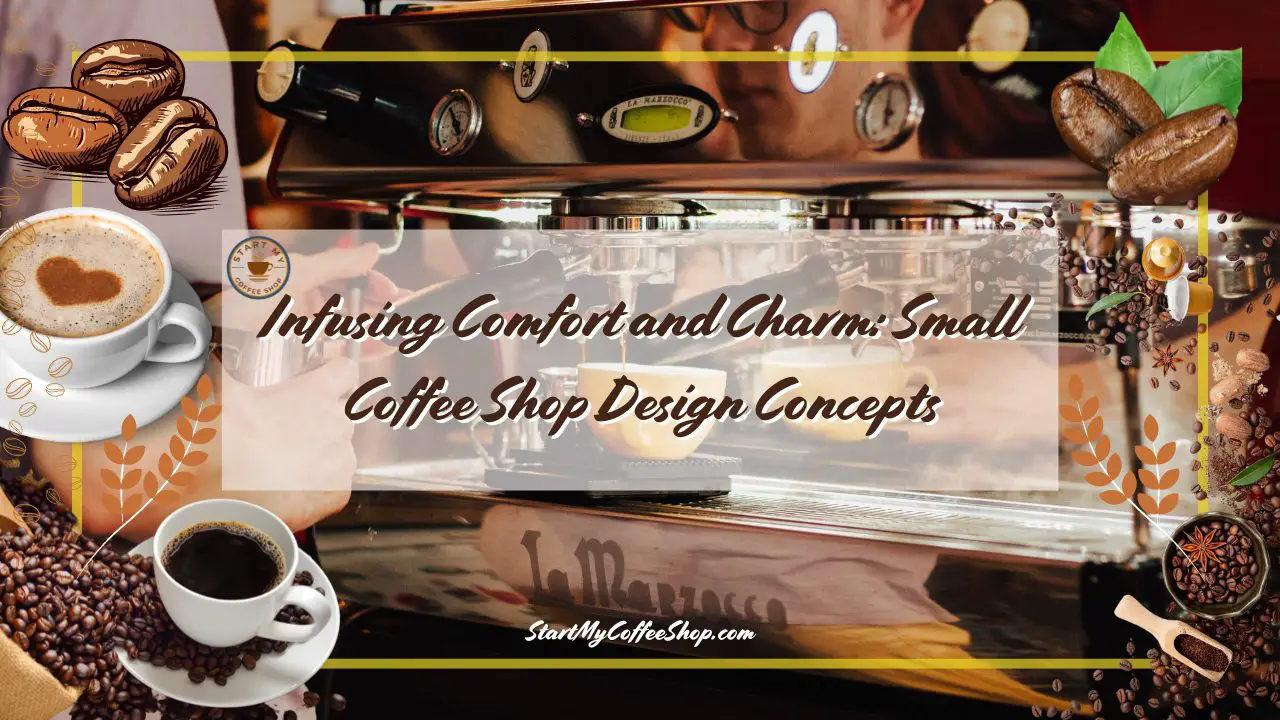Designing your coffee shop is an exciting endeavor that requires careful planning and attention to detail. From defining your concept to creating an inviting ambiance, there are several key steps and considerations to keep in mind.
 Key steps for designing your coffee shop:
Key steps for designing your coffee shop:
- Define your concept and target audience.
- Plan the layout and functional zones.
- Select suitable furniture and equipment.
- Design an inviting and comfortable ambiance.
- Create an efficient workflow and service area.
- Consider branding elements and signage.
- Ensure compliance with health and safety regulations.
This article will guide you through the process, providing insights and practical tips to help you design a unique coffee shop.
Define Your Concept and Target Audience
 The initial and pivotal step in designing your coffee shop is defining your concept and identifying your target audience. It is crucial to determine what sets your coffee shop apart from others in the market.
The initial and pivotal step in designing your coffee shop is defining your concept and identifying your target audience. It is crucial to determine what sets your coffee shop apart from others in the market.
Do you envision it as a cozy neighborhood café where locals can gather and unwind, or do you aspire to create a trendy specialty coffee bar that attracts a more hip and discerning crowd? The concept you choose will profoundly influence the overall design and atmosphere of your space.
When developing your coffee shop’s concept, consider various factors that will shape its identity. Begin by contemplating the type of coffee you want to serve. Will you focus on traditional espresso-based beverages, or will you showcase a wide range of single-origin pour-overs?
Additionally, ponder the menu offerings beyond coffee, such as pastries, sandwiches, or vegan options. Craft a menu that complements your coffee choices and caters to your target audience’s tastes.
The experience you intend to create for your customers should be at the forefront of your concept development. Think about the ambiance you want to foster. Will it be a place for relaxation and tranquility or a vibrant and energetic space? Reflect on the atmosphere you desire to establish and consider how your concept can support it.
Conduct thorough research to ensure your concept aligns with the preferences and demands of your target audience. Analyze the local market and assess what types of coffee shops are already present. Identify any gaps or opportunities that you can capitalize on.
Study the demographics, interests, and habits of your potential customers. This will help you tailor your concept to their needs, ensuring a strong connection and resonance with your target audience.
Plan the Layout and Functional Zones
 Efficient space planning is a vital aspect of designing a coffee shop. To begin, take the time to sketch a detailed floor plan that carefully considers the functional zones within your space. These zones typically include the service area, seating area, and preparation area. Ensuring a smooth flow between these zones is essential to provide a seamless experience for both customers and staff.
Efficient space planning is a vital aspect of designing a coffee shop. To begin, take the time to sketch a detailed floor plan that carefully considers the functional zones within your space. These zones typically include the service area, seating area, and preparation area. Ensuring a smooth flow between these zones is essential to provide a seamless experience for both customers and staff.
When determining the layout, think about the location of the entrance and how it influences the overall flow of traffic within the coffee shop. Strategically position the counter to allow for easy access and visibility for both customers and baristas.
Consider the placement of the seating area, ensuring it is well-spaced and conducive to comfortable movement. Adequate spacing between tables and chairs is crucial for customers to navigate through the space without feeling cramped.
Accessibility is also a key consideration. Locate restrooms in a convenient and easily accessible area within the coffee shop. Providing clear signage will help customers easily locate these facilities.
Maximizing the available space is important, but it should not come at the expense of customer comfort. Strike a balance between efficient utilization of space and creating a welcoming atmosphere.
Avoid overcrowding by allowing sufficient room for customers to move freely and comfortably. Consider different seating options such as booths, communal tables, and cozy corners to cater to different customer preferences.
In addition to customer areas, don’t forget to allocate space for essential behind-the-scenes operations. Plan for storage areas to store ingredients, supplies, and other items needed for daily operations.
Designate an area for equipment such as coffee machines, grinders, and dishwashing stations. It is also crucial to provide a dedicated workspace for staff to prepare drinks and interact with customers efficiently.
Select Suitable Furniture and Equipment
The selection of furniture and equipment plays a crucial role in creating a comfortable and functional coffee shop. When choosing furniture, it is essential to align it with your coffee shop’s concept while prioritizing customer comfort.
Opt for seating options that reflect the ambiance you want to create, whether it’s cozy armchairs, sleek bar stools, or communal tables. Consider the durability of the furniture to withstand the daily wear and tear of a bustling coffee shop. Additionally, choose materials that are easy to clean and maintain, ensuring a hygienic environment for your customers.
Aesthetic appeal is another important factor to consider when selecting furniture. The furniture should complement the overall design and atmosphere of your coffee shop. Whether you prefer a modern, minimalist look or a rustic, vintage vibe, choose furniture that enhances the desired aesthetic.
When it comes to equipment, investing in high-quality espresso machines, grinders, and brewing equipment is essential for delivering consistent and exceptional coffee to your customers. Prioritize reliability, functionality, and performance when choosing these items. Consult with industry professionals or experienced baristas to help you select the right equipment for your specific needs.
In addition to customer-facing equipment, don’t overlook the importance of allocating sufficient space for storage. Proper storage solutions for ingredients, supplies, and equipment will help maintain organization and streamline operations.
Consider ergonomic considerations as well, ensuring that workstations and equipment are positioned at comfortable heights and angles to promote a healthy and efficient work environment for your staff members.
Read more about Cost to Open Coffee Shop Average: From Concept to Cash Register
Design an Inviting and Comfortable Ambiance
Creating an inviting and comfortable ambiance is a key element in attracting and retaining customers in your coffee shop. One essential aspect to consider is the color scheme. Choose colors that align with your concept and evoke the desired atmosphere.
Warm and earthy tones such as browns, oranges, and deep reds can create a cozy and inviting feel, while brighter and bolder colors like blues and yellows may suit a more vibrant and energetic space.
Lighting is another crucial factor in setting the mood. Incorporate a combination of natural light, ambient lighting, and task lighting to create a warm and well-lit environment. Large windows or skylights can allow natural light to fill the space during the day, creating a pleasant and welcoming atmosphere. In the evenings, use ambient lighting to provide a soft and comforting glow, while task lighting can highlight specific areas such as the counter or seating areas.
Adding decorative elements can significantly enhance the visual appeal of your coffee shop. Consider incorporating artwork, whether it’s paintings, photographs, or murals, to create a visually stimulating environment.
Plants can bring a touch of nature and freshness to the space, adding a sense of calmness and improving air quality. Unique focal points like statement pieces of furniture or eye-catching displays can also contribute to the overall ambiance.
Acoustics should not be overlooked. Ensure a comfortable level of noise within the coffee shop by incorporating sound-absorbing materials such as acoustic panels or curtains. This helps prevent excessive echoes and maintains a pleasant atmosphere where customers can engage in conversations or relax in peace.
Create an Efficient Workflow and Service Area
An efficient workflow and a well-designed service area are crucial for the smooth and seamless operation of your coffee shop. When designing the service area, keep the customer journey in mind. Ensure easy access to menus, condiments, and payment options, so customers can make their choices without any confusion or delays. Display menu boards and make sure they are positioned where they can be easily seen.
Organize the counter area in a way that promotes efficient communication and workflow between baristas and customers. Consider the placement of equipment such as espresso machines, grinders, and other tools to optimize the barista’s movements and minimize waiting times. Keep the counter uncluttered and well-organized, ensuring that all necessary items are within reach for the baristas.
Implementing an intuitive queuing system is essential to maintain a smooth flow of customers. Designate clear pathways and waiting areas to guide customers through the ordering process. Consider using digital signage or ticket systems to streamline the queuing process and provide customers with a sense of order and control.
Strategic positioning of pickup areas is important to prevent congestion and ensure a convenient experience for customers. Allocate space near the counter for customers to pick up their orders, while leaving enough room for other customers to place new orders. This helps maintain a steady flow and prevents bottlenecks during peak hours.
Consider Branding Elements and Signage
Branding is a powerful tool in setting your coffee shop apart from the competition. It is essential to develop a unique brand identity and incorporate it into various design elements throughout your coffee shop. This includes signage, logos, menu boards, packaging materials, and even staff uniforms. Consistency in branding creates a cohesive and memorable experience for your customers.
When designing signage, prioritize visibility, clarity, and aesthetic appeal. Ensure that your signage is easily visible both from a distance and up close, allowing customers to locate your coffee shop easily. Informative signage helps customers navigate the space, find the menu, and understand your offerings. Aesthetically pleasing signage enhances the overall ambiance and reinforces your brand’s image.
Investing in quality materials and professional signage services is crucial to ensure a polished and cohesive look. High-quality signage not only conveys professionalism but also withstands wear and tear, maintaining its visual appeal over time.
Collaborating with professionals who understand the art of branding and design can help you create a visually appealing and impactful presence for your coffee shop.
Consistency in branding across all touchpoints is key. Ensure that your logo, color scheme, and design elements are consistent in your signage, menus, packaging, and online presence. This creates a recognizable and memorable brand identity that customers can connect with and recall easily.
Read more about Cost to Open Coffee Stand: Evaluating the Financial Commitment to a Coffee Stand
Ensure Compliance with Health and Safety Regulations
Maintaining a safe and hygienic environment is paramount in the food service industry, and it should be a top priority when designing your coffee shop. Start by familiarizing yourself with the local health and safety regulations that apply to your area. Ensure that your coffee shop’s design and layout comply with these regulations to guarantee the well-being of your customers and staff.
Consider important factors such as proper ventilation to ensure a fresh and clean air supply. Adequate handwashing facilities are essential, so allocate space for sinks with hot and cold running water, soap dispensers, and hand dryers or paper towel dispensers. Strategically place these facilities to encourage frequent handwashing among your staff.
Pay careful attention to the design of your storage areas to prevent cross-contamination and ensure proper food safety. Consider separate storage spaces for raw and cooked foods, as well as appropriate temperature control measures.
Design your coffee shop in a way that allows for easy cleaning and maintenance. Choose materials and finishes that are resistant to moisture and stains, facilitating thorough cleaning and minimizing the risk of contamination. Incorporate smooth and easily cleanable surfaces, such as stainless steel or tile, in areas where food preparation occurs.
Regularly train and educate your staff on health and safety practices. Provide comprehensive training on food handling, proper cleaning procedures, and hygiene protocols. Emphasize the importance of maintaining a high standard of cleanliness and reinforce the significance of following health and safety guidelines.
Summary
Designing your coffee shop requires a careful balance of creativity, functionality, and attention to detail. By following these key steps and considerations, you can create a coffee shop that not only reflects your unique vision but also provides an exceptional experience for your customers.
Frequently Asked Questions
Q: What are the key factors to consider when selecting furniture for my coffee shop?
A: When selecting furniture, consider factors such as comfort, durability, and aesthetic appeal. Choose pieces that align with your coffee shop’s concept and provide a welcoming atmosphere for your customers.
Q: How can I create an inviting ambiance in my coffee shop?
A: To create an inviting ambiance, focus on elements such as lighting, color scheme, and decorative elements.
Q: What permits and regulations should I be aware of when designing my coffee shop?
A: It’s important to familiarize yourself with local permits and regulations related to health, safety, and building codes.

Hi! I’m Shawn Chun
My adventure in coffee began when I first launched my first coffee shop back in the early 2000s. I had to figure out so many things on my own and to make it worse within 2 years of opening two large corporate coffee chains moved in just blocks away from me!
As I saw smaller and even some larger coffee shops in the neighborhood slowly lose customers to these giant coffee chains and slowly close up shop, I knew that I had to start getting creative…or go out of business.
I (like you may be) knew the coffee industry well. I could make the best latte art around and the foam on my caps was the fluffiest you have ever seen. I even had the best state-of-the-art 2 group digital Nuova Simonelli machine money could buy. But I knew that these things alone would not be enough to lure customers away from the name brand established coffee shops.
Eventually, through lots of trial and error as well as perseverance and creativity I did find a way to not only survive but also thrive in the coffee/espresso industry even while those corporate coffee chains stayed put. During those years I learned to adapt and always faced new challenges. It was not always easy, however, in the end, I was the sole survivor independent coffee shop within a 10-mile radius of my location. Just two corporate coffee chains and I were left after that year. All told the corporate coffee chains took down over 15 small independent coffee shops and kiosks and I was the last one standing and thriving.
Along the years I meet others with the same passion for coffee and I quickly learned that it is not only “how good a barista is” that makes a coffee shop successful, but the business side of coffee as well.
Hence why I started this website you are on now. To provide the tools and resources for up and coming coffee shop owners to gain that vital insight and knowledge on how to start a coffee shop successfully.
Stick around, browse through my helpful blog and resources and enjoy your stay! With lots of LATTE LOVE!
Shawn






